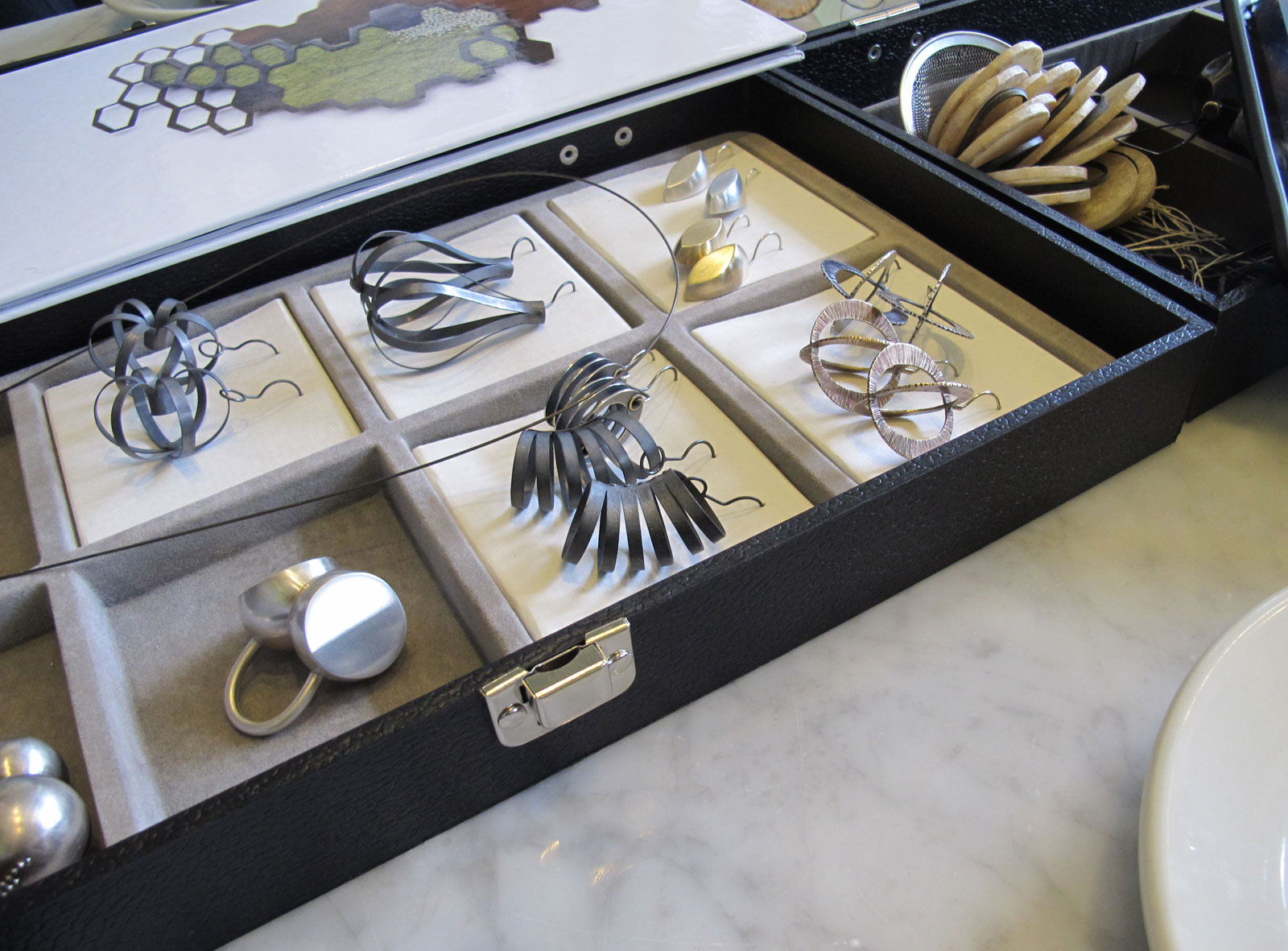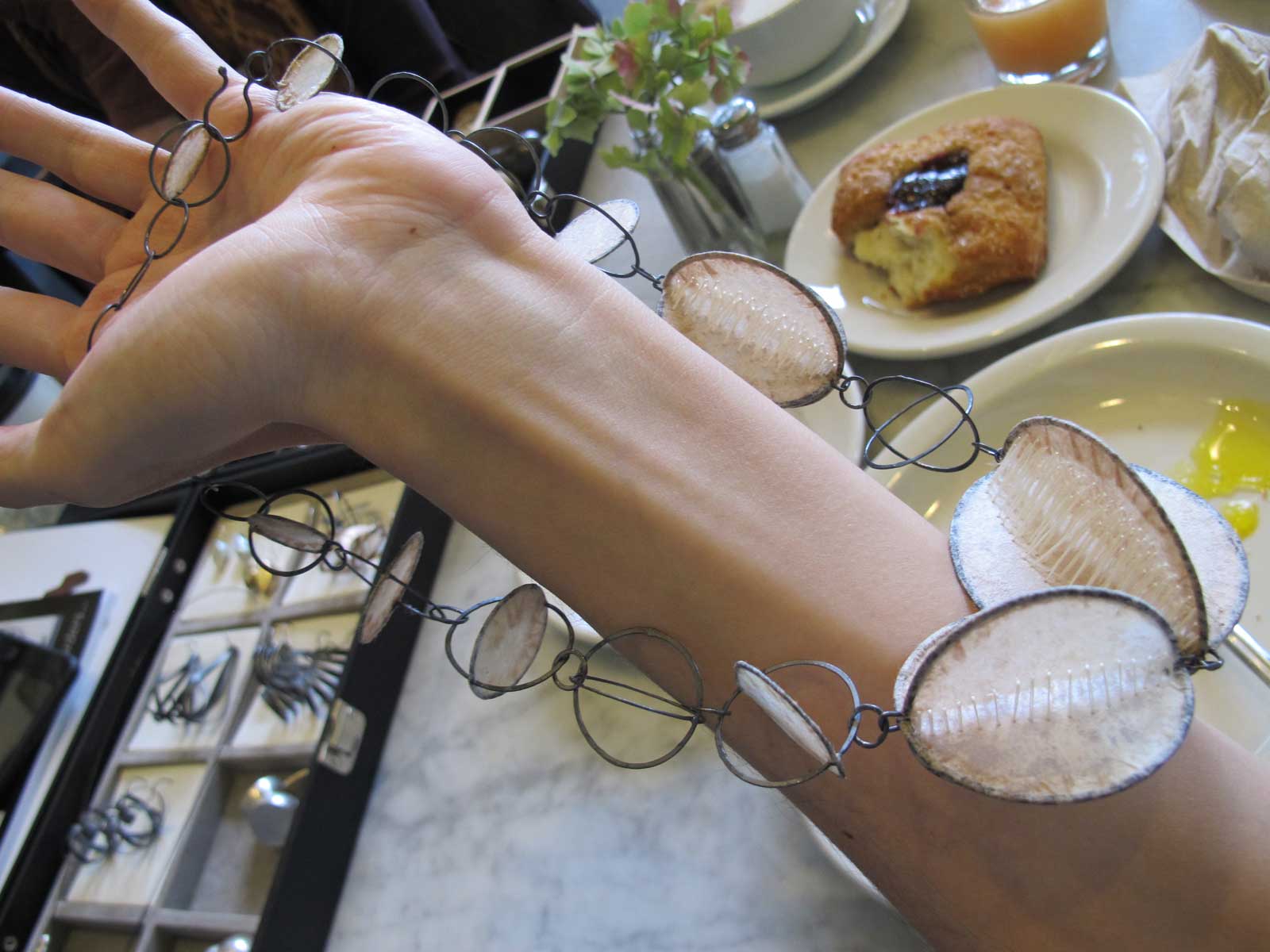There is something in the air nowadays. A new generation of jewelers are finding their stride, and the results bode well for the future of contemporary art jewelry. Several of them found their wings under the masters of the current generation. Although they learned from mentors with a very developed style, these young jewelers have found a distinctive voice and separate identity which is marvelous to witness. Sara Owens is one of these, and her impeccably forged metalwork and use of quite peculiar found objects makes her one to watch.
Owens apprenticed with Nancy Worden; both are Washington State residents. Worden is famous (some might say infamous) for her provocative mixed media jewelry which strives to make and communicate statements that cause a rethink about taboo subjects. Her meticulous metallurgic skills combine with teletype, old photographs, and a wide variety of society’s detritus to create jewelry with a feeling of antiquity and age, as if from an earlier time. This is her voice. Owens herself is on quite a different path, one which speaks with its own pitch and rhyme, and is embellished with immaculate technique and surprising secret materials.
The bread and butter of Owens’s work is in exemplary hot- and cold-worked sterling silver, oxidized or otherwise. Her staple pieces, so far, are pumpkin, pear, and caterpillar-shaped earrings, featuring strips of silver curved into gently holistic ensembles that are pleasing to the eye both on and off the body. The darkened steel look of the oxidized silver makes them a good contrast for lighter skin or white clothes. She also makes pure sterling silver rings that are two conjoined half-spheres, merging together like amniotic cells, but with a sharp flat plateau that gleams like a mirror. A simple curved wire completes the piece, forming the mount for one’s finger. With a few small indentations, there is the feel of a salt and pepper shaker, and all together the solidity of the design feels very immediate and powerful. Again, Owens’s ability as a metalsmith are eminently felt in all of these pieces of jewelry.
Novelty in alternative materials is a big thing in the contemporary art world. Often, the shock factor is perceived as quality, but this wears off once something becomes passé. Now, when you hear about pig femurs and coffee filters, the more jaded among you might have the same feelings pass through your mind. “Oh, more shock value. More mindless entertainment. More titillation.” Thankfully, with Sara Owens, nothing could be farther from the truth.
In her hands, coffee filters becomes a form of papier mache. Molded into disks, or as the skin for a rubber bulb, they take on the quality of bone and handmade paper, organic yet also not, a gorgeous contradiction in terms that renders it endlessly fascinating to the eye. One brooch pairs those bone-skin disks (stretched over the plastic tops of spice shakers) with a wire mesh top, which might have well come from a tea strainer, trailed by white and black strands which fall like a wild veil of stinging tentacles. Dark, light and silver are an easy arrangement of color theory, but seldom is it accomplished in such a complex expression.
Now, for the pig femur. In pendant form, it is a little difficult to recognize, particularly as Owens pairs it with a ball joint metal figure which keeps one’s attention from firmly grasping the identity of the skeletal component. In fact, both mirror each other, one formed from inorganic metal, the other from formerly living animal. The two orbs echo each other, demonstrating that Owens’ grasp of design equals her innovative selection of materials. A large, almost rectangular blackened metal wire loop attaches the would-be pendant to a necklace, and two pronged projections, like orthopaedic surgical attachments, marry the bone to the metal.
Her pieces range from lightweight to sizeable; heftiness is an attribute of several of her pendants and rings that is derived from a solidity of construction. They feel weighty, firm, and well-made. These feel like industrial parts, but refined and rendered unto elegant form. Engineering but with no clear purpose, except, perhaps, aesthetic expression, abounds in Owens’ jewelry.
Engineered. There is an enthusiasm to Owens’ life with her husband that seems to transfer “personal responsibility” to everything they do. With the help of friends and family, they recently built their own small house, entirely from scratch, in wooden construction but high tech amenities, such as heated benches. (Well, not high tech; rather, cleverly made!) By having a hand in what they eat, what they make, and where they live, Owens assumes a level of personal responsibility over her life that she seeks to see reflected in the world around her in terms of social justice and environmental issues.
With her simple but complicated minimalist aesthetic and passionate dedication to doing-it-yourself, this young Washingtonian is part of a new generation of skilled and expressive craftspeople who bridge tradition and the contemporary.



